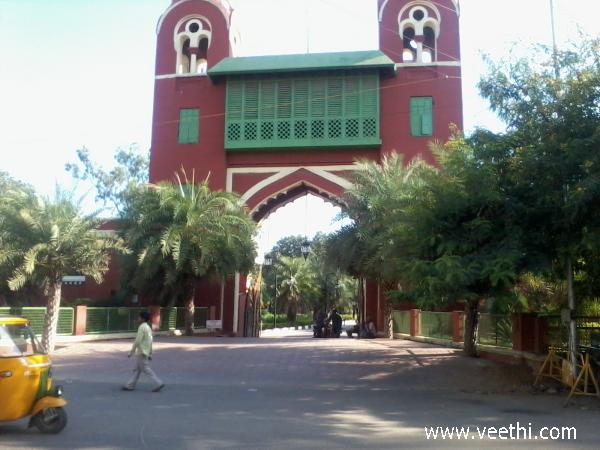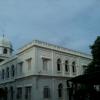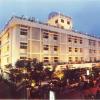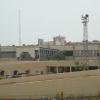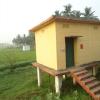Amir Mahal, Royapettah, Chennai

Please copy & paste this embed code onto your site:
Description
Amir Mahal is the official residence of the titular Nawab of Arcot and his family. Situated in Royapettah, a suburb in the present Chennai India, it was constructed in Indo-Saracenic style in 1798, the Amir Mahal has been the residence of the family since 1876. The Nawab’s successor, Mohummad Abdul Ali, and his three brothers still live in the palace with their families. It also has a mini cricket ground which is currently being renovated by the government. he Amir Mahal was constructed in 1798 by the British East India Company to house administrative offices of the company. When the Carnatic kingdom was annexed by the Company in 1855 as per the Doctrine of Lapse, the Chepauk Palace, the official residence of the Nawabs, was auctioned off and purchased by the Madras government. The Nawab moved to a building called Shadi Mahal on Triplicane High Road and lived there.[2] However, the British felt that the Shadi Mahal was "not a place fit for the residence of the Prince of Arcot" and granted him the Amir Mahal in Royapettah. Robert Chrisholm was given the task of converting the office building into a palace. In 1876, the Nawab moved in with his family into the Amir Mahal. he mahal has since been the residence of the Nawabs of Arcot. Amir Mahal is a palace belongs to the Royal family of Arcot and presently the residence of His Highness Nawab Mohammed Abdul Ali Azim Jah, the eighth Prince of Arcot. Situated on an area of approx. 14 acres, Amir Mahal was built in 1789 and came into possession of the Arcot Royal Family in 1870. The 70-room Amir Mahal is the home to 600 people (family members, staff and their families) The compound wall on the northern side abuts on Pycrofts Road and resembles the wall of a fort. A large tower on either side of the wide arched entrance adds to this impression. On top of these towers is the 'Nagarkhana', where drums are played. From one particular spot on the road, one can see the Amir Mahal Palace through the entrance located far away. There are towers on either side of the palace too. During the time of His Highness Prince Azim Jah Bahadur, the first Prince of Arcot, the Royapettah Police Court functioned in the present Amir Mahal building. The Government wanted to make a gift of this building to His Highness the Prince of Arcot and desired that his successors-in-title reside in this palace in future, but the Prince of Arcot represented to the Government that in the meagre income he and his successors received, they were not in a position to lookafter the upkeep and repairs of the palace and to pay municipal taxes, and requested the Government to sanction a budget for the upkeep and annual repairs of the palace. The Government agreed to his proposals and added the aforesaid expenditure in the public budget. The premises where the present Egmore Court is situated, was purchased by the Government for Rs.45,OOO/- and the Royapettah Police Court was shifted there. The older building, subsequently known as Royapettah House, was converted into a residential building after making certain alterations and improvements for the use and occupation of the Prince of Arcot for the time being. His Highness Prince Azim Jah Bahadur refused to shift to Amir Mahal as Shadi Mahal was the residence of some of his ancestors and suggested that his sons and one after another by terms would shift there according to the desire of the Government. Accordingly, his successors occupied the Palace. His Highness Prince Zahir-ud-Dowla Bahadur was the first Prince to occupy the building after the completion of the alterations and additions. It was the desire of His Highness Prince Azim Jah Bahadur that the name of the building be changed, from Royapettah Police Court to Amir Mahal. His Highness Prince Zahir-ud-Dowla Bahadur, the second Prince of Arcot shifted from Shadi Mahal to Amir Mahal in 1876 and thereafter his successors-in-title begun residing there and all the privileges attached to Shadi Mahal were transferred to Amir Mahal. The Government stopped paying Rs.1,000/- monthly towards rent of Shadi Mahal and began allotting budget for Amir Mahal for upkeep and maintenance and annual repairs. As per the representations made by the Prince, the Government agreed to maintain the building, carry on the repairs, replenish all the fittings, furniture etc., and pay all levies and taxes in respect of the property. The Government had also granted to Amir Mahal all privileges and formalities attached to Shadi Mahal.
Customer Ratings





0 Total
- 50
- 40
- 30
- 20
- 10
Like this photo? say something
More Photos Around Chennai
Photos from Popular Indian Cities
Photos from the States and Union Territories
- Andaman and Nicobar Islands
- Andhra Pradesh
- Arunachal Pradesh
- Assam
- Bihar
- Chandigarh
- Chhattisgarh
- Dadra and Nagar Haveli
- Daman and Diu
- Delhi
- Goa
- Gujarat
- Haryana
- Himachal Pradesh
- Jammu and Kashmir
- Jharkhand
- Karnataka
- Kerala
- Lakshadweep
- Madhya Pradesh
- Maharashtra
- Manipur
- Meghalaya
- Mizoram
- Nagaland
- Orissa
- Puducherry
- Punjab
- Rajasthan
- Sikkim
- Tamil Nadu
- Telangana
- Tripura
- Uttar Pradesh
- Uttarakhand
- West Bengal



